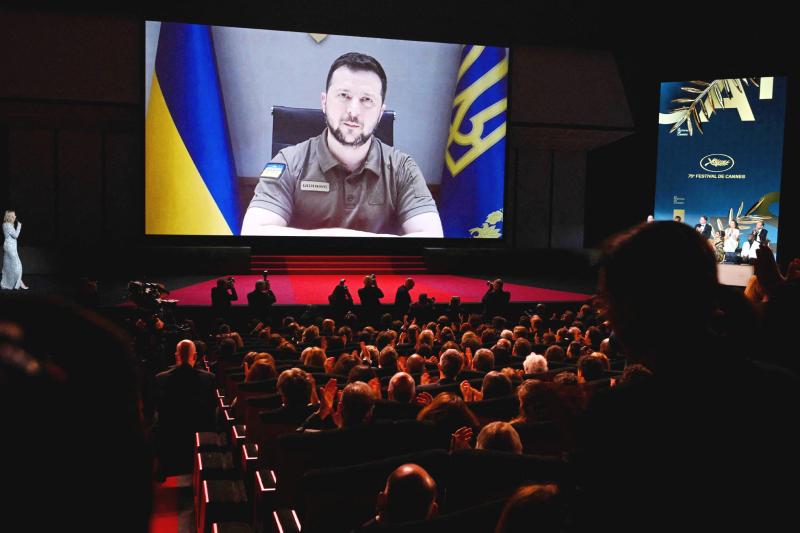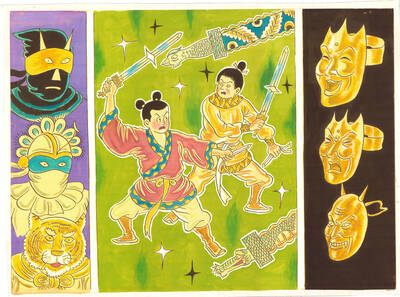The 75th Cannes Film Festival kicked off Tuesday with an eye turned to Russia’s war in Ukraine and a live satellite video address from Ukrainian President Volodymyr Zelenskyy, who called on a new generation of filmmakers to confront dictators as Charlie Chaplin satirized Adolf Hitler.
After tributes and musical numbers, Zelenskyy was streamed live for the formally attired audience who had gathered for the premiere of Michel Hazanavicius’ zombie comedy Final Cut.
Zelenskyy, dressed in his signature olive green shirt, drew a thunderous standing ovation and and spoke at length about the connection between cinema and reality. He referenced films like Francis Ford Coppola’s Apocalypse Now and Charlie Chaplin’s The Great Dictator as not unlike Ukraine’s present circumstances.

Photo: AFP
Zelenskyy quoted Chaplin’s final speech in The Great Dictator, which was released in 1940, in the early days of World War II: “The hate of men will pass, and dictators die, and the power they took from the people will return to the people.”
“We need a new Chaplin who will demonstrate that the cinema of our time is not silent,” implored Zelenskyy.
The Ukrainian president pushed filmmakers not to “stay silent” while hundreds continue to die in Ukraine, the largest war in Europe since World War II, and show that cinema “is always on the side of freedom.”

Photo: AFP
The war is to be a regular presence in Cannes, where the festival has barred Russians with ties to the government from attending this year. Set to screen are several films from prominent Ukrainian filmmakers, including Sergei Loznitsa’s documentary The Natural History of Destruction. Footage shot by Lithuanian filmmaker Mantas Kvedaravicius before he was killed in Mariupol in April will also be shown by his fiancee, Hanna Bilobrova.
Even Final Cut,” the latest film from The Artist filmmaker Hazanavicius, was renamed from its original title, Z, after Ukrainian protesters noted that the letter Z to some symbolizes support for Russia’s war in Ukraine.
Formally attired stars including Eva Longoria, Julianne Moore, Berenice Bejo and No Time to Die star Lashana Lynch were among those who streamed down Cannes’ famous red carpet Tuesday. More star-studded premieres — Top Gun: Maverick! and Elvis! — await over the next 12 days, during which 21 films will vie for the festival’s prestigious top award, the Palme d’Or.

Photo: AFP
But Tuesday’s opening and the carefully choreographed red-carpet parade leading up the steps to the Grand Theatre Lumiere again restored one of the movies’ grandest pageants after two years of pandemic that have challenged the exalted stature Cannes annually showers on cinema.
“Dear friends, let’s come out of this dark together,” said opening ceremony host Virginie Efira.
After last year requiring regular COVID-19 testing and masks in theaters — and no kisses on the red carpet — Cannes has largely done away with pandemic protocols. Masks are recommended inside but are rarely worn.
Cannes presented an honorary Palme d’Or to Forest Whitaker, who received a standing ovation. Whitaker, who won best actor at Cannes 34 years ago for his performance as Charlie Parker in Clint Eastwood’s Bird, said that while ascending the steps to the Palais des Festivals on Tuesday, he could still hear chants of “Clint! Clint!” ringing in his ears. Eastwood is one of few others who have been awarded an honorary Palme.
On Tuesday, Cannes also unveiled the jury that will award the Palme d’Or. French actor Vincent Lindon is leading a jury that includes Deepika Padukone, Rebecca Hall, Asghar Farhadi, Trinca, Ladj Ly, Noomi Rapace, Jeff Nichols and Joachim Trier.
Questions of gender equality have long surrounded the Cannes Film Festival, where no more than five female filmmakers have ever been a part of the Palme competition lineup and only two women directors have won it. On Monday, Fremaux defended the festival, arguing that it selects films purely on the basis of quality. Hall, who last year made her directorial debut with the film “Passing,” was asked about her opinion on Cannes’ record.
“I believe that it is a work in progress. I mean for the whole film industry, not just the Cannes Film Festival,” replied Hall. “The way of dealing with these things needs to be addressed on a grassroots level as well. It’s not just the festivals or public-facing situations. It’s about all the minutiae of what goes into the industry at large.”
Farhadi, the Oscar-winning Iranian director, also spoke for the first time about an ongoing plagiarism suit regarding his previous film, “A Hero,” which won the Grand Prix in Cannes last year. A former film student of Farhadi’s, Azadeh Masihzadeh, has accused him of stealing the idea of the film from a 2018 documentary she made in a workshop taught by Farhadi.
Speaking at length, Farhadi said A Hero was not based on the documentary.
“It was based on a current event so this documentary and this film are based on an event that happened two years prior to the workshop,” said Farhadi. “When an event takes place and is covered by the press, then it becomes public knowledge and you can do what you like about the event. You can write a story or make a film about the event. You can look up the information on this event. ‘A Hero’ is just one interpretation of this event.”
At the tradition-upholding Cannes, the world’s largest and most glitzy temple to film, cinema, controversy and glamour swirl together in a 12-day spectacle of red carpet premieres and rampant movie deal-making up and down the Croisette. Theatrical release is a requirement of any film vying for the Palme, which has prevented streaming services from playing a big role at Cannes.
But this year, one new festival partner — TikTok — has raised some eyebrows. The festival is hosting TikTok creators from around the world and holding a separate contest for best (very short) videos created during the festival. Thierry Fremaux, artistic director of Cannes, granted TikTok wasn’t the future of cinema.
“The cinema remains the final art,” said Fremaux.

In late October of 1873 the government of Japan decided against sending a military expedition to Korea to force that nation to open trade relations. Across the government supporters of the expedition resigned immediately. The spectacle of revolt by disaffected samurai began to loom over Japanese politics. In January of 1874 disaffected samurai attacked a senior minister in Tokyo. A month later, a group of pro-Korea expedition and anti-foreign elements from Saga prefecture in Kyushu revolted, driven in part by high food prices stemming from poor harvests. Their leader, according to Edward Drea’s classic Japan’s Imperial Army, was a samurai

Located down a sideroad in old Wanhua District (萬華區), Waley Art (水谷藝術) has an established reputation for curating some of the more provocative indie art exhibitions in Taipei. And this month is no exception. Beyond the innocuous facade of a shophouse, the full three stories of the gallery space (including the basement) have been taken over by photographs, installation videos and abstract images courtesy of two creatives who hail from the opposite ends of the earth, Taiwan’s Hsu Yi-ting (許懿婷) and Germany’s Benjamin Janzen. “In 2019, I had an art residency in Europe,” Hsu says. “I met Benjamin in the lobby

April 22 to April 28 The true identity of the mastermind behind the Demon Gang (魔鬼黨) was undoubtedly on the minds of countless schoolchildren in late 1958. In the days leading up to the big reveal, more than 10,000 guesses were sent to Ta Hwa Publishing Co (大華文化社) for a chance to win prizes. The smash success of the comic series Great Battle Against the Demon Gang (大戰魔鬼黨) came as a surprise to author Yeh Hung-chia (葉宏甲), who had long given up on his dream after being jailed for 10 months in 1947 over political cartoons. Protagonist

A fossil jawbone found by a British girl and her father on a beach in Somerset, England belongs to a gigantic marine reptile dating to 202 million years ago that appears to have been among the largest animals ever on Earth. Researchers said on Wednesday the bone, called a surangular, was from a type of ocean-going reptile called an ichthyosaur. Based on its dimensions compared to the same bone in closely related ichthyosaurs, the researchers estimated that the Triassic Period creature, which they named Ichthyotitan severnensis, was between 22-26 meters long. That would make it perhaps the largest-known marine reptile and would